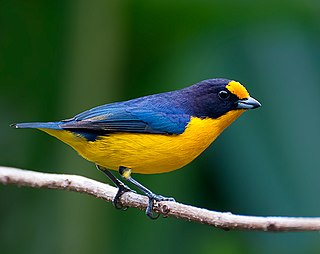
The violaceous euphonia is a small passerine bird in the true finch family. It is a resident breeder from Trinidad, Tobago and eastern Venezuela south to Paraguay and northeastern Argentina. The bird's range in northern Brazil is the lower portion of the Amazon Basin and the adjacent Tocantins River drainage, with its northwestern limits from Brazil and the Guyanas, the eastern banks of the Orinoco River drainage in central Venezuela.
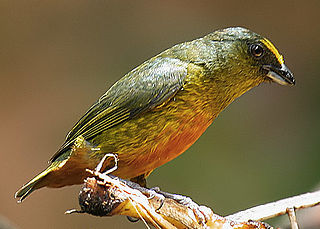
The olive-backed euphonia is a small passerine bird in the finch family. It is a resident breeder in the Caribbean lowlands and foothills from southern Mexico to western Panama.

The scrub euphonia is a species of bird in the family Fringillidae.

The golden-sided euphonia is a species of bird in the family Fringillidae. It is found in northern Brazil, French Guiana, Guyana, Suriname and eastern Venezuela. Its natural habitat is subtropical or tropical moist lowland forest.
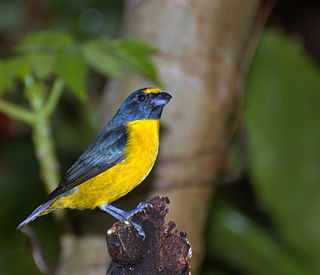
The green-chinned euphonia is a species of bird in the family Fringillidae. It is found in far northeastern Argentina, Brazil and Paraguay. Its natural habitat is subtropical or tropical moist lowland forest. It is threatened by habitat loss.

The white-lored euphonia or golden-bellied euphonia is a songbird species of the family Fringillidae, having recently been moved there from the Thraupidae.
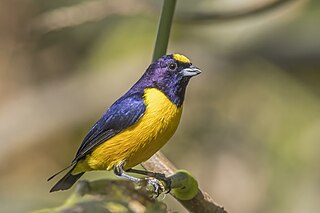
The velvet-fronted euphonia is a species of bird in the family Fringillidae, having recently been moved there from the Thraupidae.

The elegant or blue-hooded euphonia is a species of bird in the family Fringillidae. It is found in Belize, Costa Rica, El Salvador, Guatemala, Honduras, Mexico, Nicaragua, and Panama. It was formerly classified in the genus Euphonia, but phylogenetic evidence indicates that it groups with Chlorophonia.
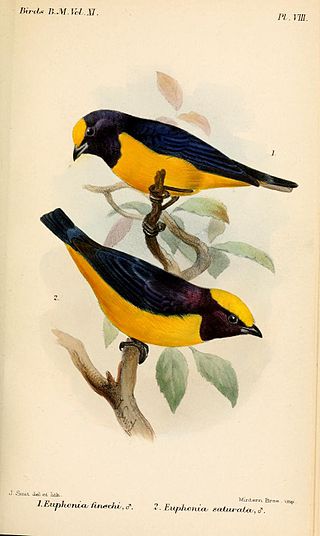
Finsch's euphonia is a species of bird in the family Fringillidae. It is found in northern Brazil, French Guiana, Guyana, Suriname and eastern Venezuela. Its natural habitats are subtropical or tropical moist lowland forest and heavily degraded former forest.
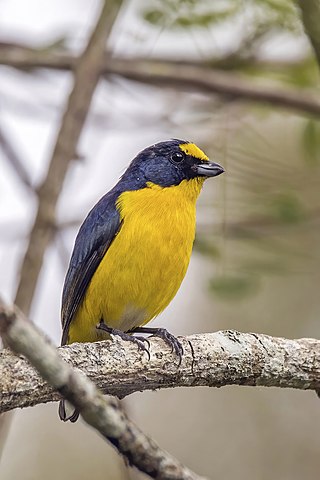
The yellow-throated euphonia is a species of songbird in the family Fringillidae. It is found in southeastern Mexico and throughout Central America with its range stretching from Belize south to western Panama. It inhabits primarily both humid and dry regions where it prefers the forest edge, open woodland, and shaded plantations. It has two subspecies, the nominate subspecies Euphonia hirundinaceahirundinacea and Euphonia hirundinacea gnatho. This finch is a small bird with pointed wings and a short bill and short tail. Males of this species have dark glossy blue-black upperparts excluding a yellow forecrown, and bright yellow underparts, while females have olive green upperparts and whitish-gray breast and lower parts. It has a shrill song that alternates between high-pitched and moderately pitched and appears to be able to mimic some calls of other birds.

The spot-crowned euphonia is a species of bird in the family Fringillidae. It is found in Costa Rica and Panama. Its natural habitats are subtropical or tropical moist lowland forest and heavily degraded former forest.

The Jamaican euphonia is a species of bird in the family Fringillidae. It is endemic to Jamaica. Its natural habitats are subtropical or tropical moist lowland forest and heavily degraded former forest.
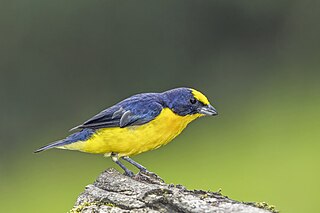
The thick-billed euphonia is a species of bird in the family Fringillidae, formerly placed in the Thraupidae.

The yellow-crowned euphonia is a species of bird in the family Fringillidae. It is found in Costa Rica, Nicaragua, and Panama, and is perhaps the most common euphonia in its range. Its natural habitats are subtropical or tropical dry forest, subtropical or tropical moist lowland forest, and heavily degraded former forest. It can be found on occasion in the canopy of small forests.
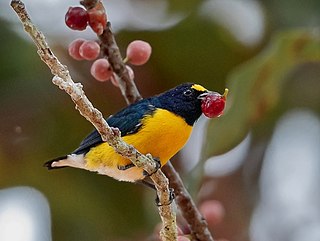
The white-vented euphonia is a species of bird in the family Fringillidae.

The Hispaniolan euphonia is a bird species in the finch family, Fringillidae that is endemic to the island of Hispaniola in the Caribbean.

The chestnut-bellied euphonia is a species of bird in the family Fringillidae. It was formerly placed with the related Thraupidae. It is found in Argentina, Brazil, and Paraguay. Its natural habitats are subtropical or tropical moist lowland forest and subtropical or tropical moist montane forest.

The plumbeous euphonia is a species of bird in the family Fringillidae. It is found in northern Brazil, Colombia, French Guiana, Guyana, Peru, Suriname, and Venezuela. Its natural habitats are subtropical or tropical moist lowland forest and heavily degraded former forest.

The Trinidad euphonia is a species of bird in the family Fringillidae. It is common in northern Colombia and northern Venezuela and uncommon to rare on the Caribbean island of Trinidad. Like all euphonias, it is small, stocky, and short-tailed; unlike some, it is sexually dimorphic. The male is glossy blue-black on the head, back, throat, and upper breast, with a bright yellow forehead and crown, and bright yellow underparts. The female is olive-green above and yellow-olive below, with a grayer patch running down the center of her breast and abdomen, and bright yellow undertail coverts. Its calls are high-pitched, plaintive whistles: the two most common are a single-pitched, double-noted "pee pee" or "tee dee", or a rising, double-noted "puwee", "cooleee" or "duu dee". Its song is a short, jumbled mix of musical and nonmusical notes.
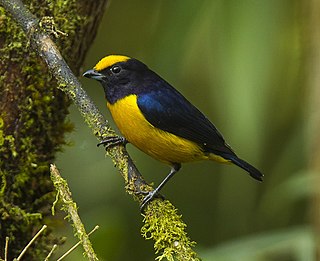
The orange-bellied euphonia is a species of bird in the finch family, Fringillidae. They were formerly considered tanagers (Thraupidae). It is found in Bolivia, Brazil, Colombia, Ecuador, Guyana, Panama, Peru, and Venezuela. Its natural habitats are subtropical or tropical moist lowland forest and subtropical or tropical moist montane forest.






















